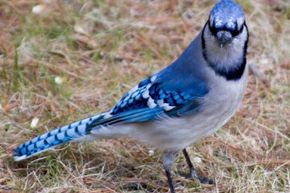Quck answer
The Blue Jay is a North American bird known for its striking blue and white feathers, distinctive crest, and loud vocalizations. They are found in forests, suburban areas, and parks, and are known for their intelligence and adaptability. Blue Jays are omnivores, feeding on insects, nuts, and seeds, and are also known to steal the eggs and nestlings of other bird species. They are highly territorial and will defend their nests aggressively. Despite being a common sight in many areas, Blue Jays face threats from habitat loss and climate change.
Wild Animals

iStockphoto |
The blue jay is a bird with bright blue crest, back and tail feathers. It has a white chest and black stripes on its wings, tail and face.
This bird can be found in deciduous forests and is also commonly seen in city parks and backyards.
During breeding season, four to six brown-spotted greenish eggs are laid and the nest is made of sticks and grass.
Blue jays bury seeds and acorns as a way to prepare for winter. The seeds that are not retrieved grow into trees and become a contribution to the environment.
Blue jays can be found at bird feeders, especially if oak trees are nearby. They tend to chase smaller birds away from feeders, making them known as the bully of the area. They usually nest in eastern hemlock and the dense forked branches of hawthorns.
FAQ
1. What is a Blue Jay?
A Blue Jay is a colorful, medium-sized bird that belongs to the Corvidae family, which also includes crows, ravens, and magpies. It is known for its striking blue and white plumage, with a black collar around the neck and a distinctive crest on the head. Blue Jays are native to North America and can be found in forests, parks, and urban areas.
2. What do Blue Jays eat?
Blue Jays are omnivores and have a varied diet. They eat insects, fruits, nuts, grains, and seeds. They are also known to eat small animals like mice, frogs, and snakes. Blue Jays have a special pouch in their throat that allows them to store food for later consumption.
3. How do Blue Jays mate?
Blue Jays form monogamous pairs during the breeding season, which lasts from March to July. The male performs a courtship display by puffing up his feathers, singing, and offering food to the female. The pair builds a nest together, usually in a tree or shrub, and both parents take turns incubating the eggs and feeding the chicks.
4. Are Blue Jays migratory?
Blue Jays are partially migratory, meaning that some populations will migrate south for the winter while others will stay in their breeding range year-round. The migration patterns of Blue Jays are influenced by food availability and weather conditions.
5. What is the lifespan of a Blue Jay?
The lifespan of a Blue Jay in the wild is typically around 7 years, although some can live up to 17 years. The main threats to their survival are habitat loss, predation, and human activity.
6. What is the role of Blue Jays in the ecosystem?
Blue Jays play an important role in the ecosystem as seed dispersers. They eat fruits and nuts and then deposit the seeds in different locations, helping to spread plant species. They also eat insects, which can help control pest populations.
7. What is the Blue Jay’s call like?
The Blue Jay’s call is loud and harsh, with a variety of sounds including screams, whistles, and rattles. They also imitate the calls of other birds and animals.
8. Can Blue Jays be kept as pets?
No, it is illegal to keep Blue Jays as pets in the United States. They are protected under the Migratory Bird Treaty Act, which prohibits the capture, sale, or possession of migratory birds without a permit.
9. Are Blue Jays aggressive?
Blue Jays can be territorial and aggressive towards other birds, especially during the breeding season. They will defend their nests and food sources from other birds and animals.
10. What is the symbolism of Blue Jays?
Blue Jays are often associated with communication, intelligence, and curiosity. In Native American folklore, they are seen as messengers between the spirit world and the physical world.
11. How can I attract Blue Jays to my backyard?
Blue Jays can be attracted to backyards by offering food like peanuts, sunflower seeds, and suet. They also prefer bird feeders that are on a pole rather than hanging, as it gives them a better perch. Providing a source of water like a bird bath can also attract Blue Jays.





Leave a Reply